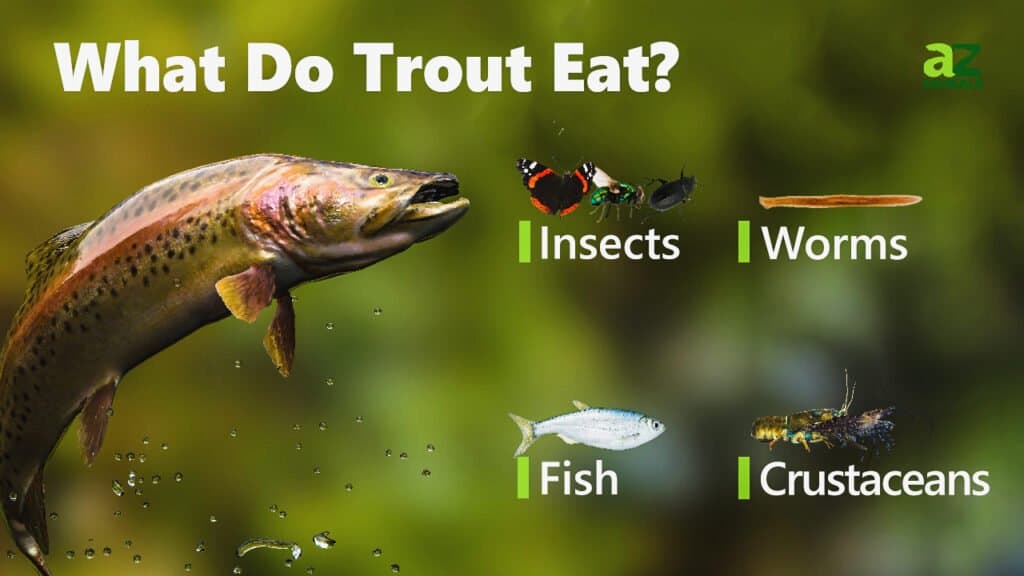Trout is the common name for several freshwater fish species. They are native to the Northern Hemisphere but have spread all around to other parts of the world. Today, wild trout can be found in North America, northern Asia, and Europe. Rainbow trout is exclusively found in 45 different countries.
Most trout, such as lake trout, live exclusively in freshwater lakes, rivers, and streams. Others, such as rainbow trout, live their entire lives in freshwater or spend two or three years at sea before returning to freshwater to breed.
These fish have long been a popular food source for both humans as well as sport fishing. So, what exactly does this highly consumed fish eat? You’ll be surprised to find that they’re far from picky eaters.
What Do Trout Eat?

Trout eat a diet that consists of aquatic insects, fish eggs, terrestrial insects, and other foods. They are predominately carnivores. Along with their main diet choices, trout are also incredibly opportunistic. They will eat just about anything that they come across. If the animal is smaller than the trout, then you can bet that they’ll try to get their mouth around it.
Trouts have even been known to eat animals that fall into the water, such as crickets and even mice! As long as the trout is able to gobble up the food choice in one bite, they will make the attempt to eat it.
Here’s A Complete List of Foods That Trout Eat:
- Small baitfish
- Ants
- Spiders
- Cock-a-bullies
- Nymphs
- Larvae
- Cicadas
- Dragonflies
- Rodents
- Other trout
- Eels
- Worms
- Crayfish
- Trout eggs
As you can see, trout have an incredibly diverse diet and are not fussy about their foods. However, for the majority of the time, they are eating nymph or larvae form of insects as it is the most readily available source of food for them.
What Do Different Types of Trout Eat?
There are many distinct types of trout – so many, in fact, that it would be impossible to list them all. However, the most common types include brook, brown, lake, cutthroat, rainbow, and steelhead trout.
What all these species have in common is that they will eat a varied diet of worms and snails, small insects & larvae, small frogs, small fish, and crayfish. However, some of these trout will have an appetite for larger prey. Brown trout and steelhead trout in particular often enjoy eating small mammals and small tortoises and turtles if given the opportunity.
Rainbow trout, on the other hand, have been known to display cannibalistic tendencies as they happen to eat the eggs of other rainbow trout, as well as other small fish species.
While some species like lake trout prefer to keep their diet simple by only indulging in plankton, small fish, crustaceans, insects, and snails.
Still, overall the diets between the trout species aren’t quite so different.
According to a study published in the New Zealand Journal of Marine and Freshwater Research, “the diet of brown trout and rainbow trout was studied in specimens from Lake Benmore, a deep, oligotrophic lake in South Island, New Zealand. Between November and July, both species fed mainly on small mollusks gleaned from the littoral weed beds.”
Overall, trout are typically opportunistic hunters and if given the chance will take it upon themselves to enjoy whatever they can fit into their mouths.
How Do Trout Hunt?
Since trout are a predatory species, they have a lot of teeth. When trout are feeding on drifting or extremely slow-moving foods such as nymphs, shrimp, small fish, and flies that show up on the surface of the water, they will typically engulf their prey.
The prey is then either transported directly to the front of the trout’s mouth by the stream or is approached by the trout themselves. Once the prey is close enough, the trout will open its mouth, flaring its gills, and then begin to suck the food into its mouth. This method of engulfing is used by many other types of predator fish including snapper, bass, and groper.
However, not all prey can be approached this way. Other prey, such as freshwater crayfish, must first be captured and then flipped tail-first toward the mouth, and swallowed otherwise the spikes and spine will strangle the trout.
When trying to capture small fish in deeper waters, trout will also surround tiny schools of fish and swim around them, taking them out one at a time.
Trout happen to have a variety of hunting methods that they display, depending on the circumstances and types of prey they are hoping to eat.
Are Trout Dangerous to Humans?
Trout is one of the most popular freshwater fish species for both commercial fishing and sportfishing. Their popularity stems from them being one of the healthiest fish that you can catch. They have all the essential minerals in varying amounts along with a great variety of vitamins and protein, making them a popular dinner dish.
However, it is important to be careful when fishing for trout. Because of the sharpness and abundance of their teeth, it’s important to handle them with care to avoid hurting your fingers. Trout also have a tendency to move around a lot. Especially once they’re caught. This makes it difficult to pull the hook out without getting a cut or a bite.
Luckily, a trout bite or cut is unlikely to harm you in a serious way. Still, it is important to take precautions in order to avoid having to cut your fishing trip short because of a bloody cut.
The photo featured at the top of this post is © FedBul/Shutterstock.com
Thank you for reading! Have some feedback for us? Contact the AZ Animals editorial team.






